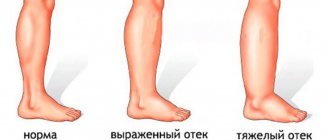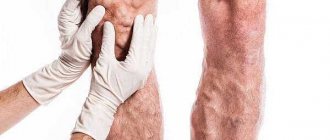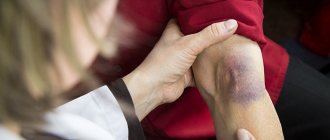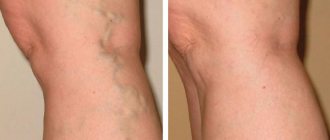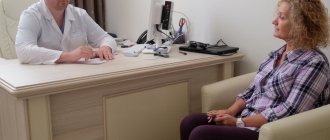Why do spider veins appear on the legs?
Spider veins and spider veins on the legs are an expansion of small intradermal veins, as a result of which they become visible as “bluish veins.” The main reason for their appearance is hormonal status: female sex hormones help reduce the tone of the veins. Accordingly, in the overwhelming majority of cases they occur in the female part of our population. This may also explain their frequent occurrence during pregnancy. In addition, contributing factors include hereditary predisposition and prolonged static loads.
Edema of the lower extremities
Along with varicose veins, swelling of the legs, ankles and feet often occurs. Edema leads to the development of chronic inflammation in the distal parts of the lower extremities.
Stage III of varicose veins: swelling in the distal parts
When you experience pain, discomfort and heaviness, these are often signs of an inflammatory response. The sensation can be relieved by elevating your legs above your heart, this helps circulate blood to your heart from your legs after long periods of sitting or standing. This problem will not be solved by itself; you need to contact a phlebologist in a good specialized medical center. The best solution would be to choose one of the best Moscow city phlebological centers, where leading specialists in this field work.
Here are the leading symptoms that should prompt you to seek medical help.
Symptoms accompanying inflammation in the legs with stage III varicose veins:
- Feeling of heaviness, fullness, swelling in the calves or ankles.
- Itching in the lower extremities.
- Numbness and pastiness in the distal parts of the lower extremities.
- Aching pain when walking and standing.
- Restless legs syndrome, when it becomes difficult to maintain a static body position.
- Muscle spasms, cramps in the calf muscles (usually at night).
Many of these symptoms are among the first serious signs of venous pathology, so if you have varicose veins and swelling, it is very important to get a diagnosis so as not to make the problem worse.
How to get rid of spider veins on your legs?
Conservative treatment (especially wearing compression stockings) is quite effective in preventing the occurrence of spider veins. However, if they have already appeared, there are two main treatment methods:
- Sclerotherapy. Using an injection, a sclerosant is injected into the main feeding vessel - a substance that causes damage and gluing of the vessel walls. Within 1-2 weeks, the vessel and the vascular network it feeds become fibrotic and disappear. The method is very effective for larger vessels.
- Percutaneous laser coagulation. Typically a neodymium laser is used. It passes through the transparent upper layers of the skin and is absorbed by the hemoglobin in the blood. The vessel heats up and it is “soldered”. This method is more effective for smaller vessels.
Which is better: sclerotherapy or laser coagulation?
These methods are not opposed, but rather complement each other. Larger vessels are better removed by sclerotherapy (it is easier to puncture them with a needle and inject the drug, there is less chance of rupture of the vein during injection, correctly administered sclerosant in the form of foam almost 100% leads to gluing of the vascular network). A small vascular network is difficult to treat with sclerotherapy due to technical reasons (the diameter of the vessels of the network can be comparable to the diameter of the needle). And for percutaneous laser coagulation, this is an advantage, since it is easier to heat and “seal” such a vessel with a laser without the possibility of burning the overlying skin. Thus, first, large vessels are removed using sclerotherapy, and then small ones are “reached” with a laser.
Blood clot in the legs: the most common symptoms
15.10.2019
The formation of a blood clot in the deep veins of the lower extremities is a dangerous disease, as there is a risk of life-threatening complications. The thrombus can break away from the vascular wall, and the venous system reaches the heart and pulmonary artery - a pulmonary embolism occurs. When the pulmonary artery is completely blocked by a blood clot , sudden death occurs.
An increased risk deep vein thrombosis occurs in smokers, pregnant women, the elderly, patients with obesity , tumors, and blood .
What are the risk factors for developing a blood clot?
Factors contributing to the formation of a blood clot:
- dehydration;
- prolonged immobilization, such as air travel;
- presence of varicose veins ;
- pregnancy ; injuries, operations ;
- blood disorders ;
- medicines - contraceptives;
- obesity.
There are three main mechanisms for the formation of blood clots:
- damage to the wall of a blood vessel . If there is damage to the vascular wall (rupture, trauma, tingling), adrenaline, norepinephrine and serotonin are released, causing vasospasm . Platelets, and then white and red blood cells cling to the lesion - a blood clot ;
- venous sagging - delayed blood flow and congestion in large vessels favor thrombosis ;
- increased blood - Increased blood occurs during injuries, surgeries, tumors, burns, and dehydration.
What are the symptoms of a thrombus (blood clot) in the veins of the lower extremities?
At an early stage, when the blood clot is small and does not completely block the lumen of the affected vein , there is no inflammation and symptoms may be absent.
Here are some classic symptoms you may experience with a blood clot in your legs:
- spontaneous pain. In some cases there may be little pain, such as heaviness or discomfort, and in other cases there may be quite a lot of pain. In an upright position, the pain intensifies;
- painful pain in the course of large vessels ;
- pain in the groin of large vessels occurs in the area of the inguinal fold, in the buttock, inside the thigh;
- provoked pain. Pain occurs in the following cases: in the dorsiflexion of the foot pain is provoked, in the lower part of the leg - due to the release of the tibial veins ; coughing and sneezing cause pain in the corresponding limb;
- swelling. Painful swelling in the area of the clot - ankle, lower leg . It is typical for the swelling to not go away with cold compresses and may be enlarged for no apparent reason;
- change in skin color. The skin turns red and then turns blue-gray. The appearance of red spots on the skin in the area of the clot is a characteristic sign of the formation of a blood clot in the deep veins . These spots do not disappear over time, but become larger;
- warming of the skin. Increased skin temperature in the area of the blood clot is a relatively early sign. Warm skin may be accompanied by other symptoms such as itching, throbbing;
- dilated superficial veins - dilated veins around the ankle, lower leg, at the base of the thigh dilate;
- general symptoms are increased heart rate, fever, dizziness , anxiety.
Published in Phlebology Premium Clinic
Is it possible to cure spider veins at home?
At home, you can and should prevent the appearance of spider veins. The most effective method is, of course, wearing compression hosiery (at least during pregnancy, on days of increased or prolonged static loads). Venotonic drugs have some effectiveness. A contrast shower, periodically throughout the day raising the legs above the level of the heart, and massage of the lower extremities (provided there are no varicose veins) will also be useful. However, it will not be possible to remove spider veins that have already appeared on the legs at home. This will require special procedures that can only be performed in a specialized clinic (sclerotherapy, percutaneous laser coagulation).
Be healthy!
Sign up for a free consultation with a phlebologist or ask any questions you have about phlebology and vein treatment by phone:
+7 (495) 255−50−11.
Modern methods of treating varicose veins
Modern diagnostic methods and a wide range of hardware make it possible to treat leg meshes at any stage of the disease. At the same time, the methods are low-traumatic and highly effective. The most popular ways to get rid of unattractive venous networks are:
- Sclerotherapy is the introduction of a special substance that glues the walls of the wreath and blocks the blood flow through them. Subsequently, they will simply dissolve in the tissue fibers;
- Removal of mesh with a laser - exposure of the veins to a special laser device, which “cauterizes” the veins on the legs. The procedure may require multiple sessions and certain requirements before and after surgery.
You can find out which method is best to treat asterisks, what additional therapy to use and what preventive measures need to be followed on our website. You can ask your phlebologist using a special contact form.

